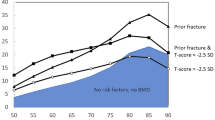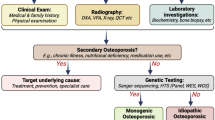Abstract:
Osteoporosis is a common disease which causes significant morbidity and mortality and in many cases may be preventable. In the absence of fragility fractures the accepted method of identifying those at high risk is based upon bone mineral density (BMD) measurements with defined cut-off points. To correctly delineate normal from abnormal, reliable reference ranges appropriate to the observed population are required. We have studied the age-dependent changes in mean BMD and standard deviation at the lumbar spine and femoral neck in a normal population extracted from 4280 women screened for osteopenia and compared our findings with the manufacturer's normal range (MNR). The recent World Health Organization criteria for the diagnosis of osteopenia and osteoporosis using the ‘manufacturer's young normal’ (MYN) values and our ‘study young normal’ (SYN) values have been applied. The study normal population (SNP) included 2068 women (mixes social class; mean age 53 years, range 30–79 years). The distribution of mean lumbar spine BMD with age in SNP was generally similar to the MNR. In contrast mean femoral neck bone density from SNP was significantly different from the MNR, ranging from 3% to 12% lower in each 5-year group analysed (p < 0.05). Comparison of standard deviations in spine BMD in SNP against the fixed MNR standard deviation showed a statistically significant increase commencing at 45 years of age. The magnitude of this increase appeared to rise with age and remained significant in the 75-to-79-year group (p < 0.05). In contrast, standard deviation in femoral neck BMD in SNP appeared relatively constant with age except in the group of women at and around the time of the menopause. The SYN value for mean lumbar spine BMD was 0.994 g/cm2 (cf. MYN value 1.047, p < 0.0001) with a standard deviation of 0.122 g/cm2 (cf. MYN 0.11, p = 0.0005). Similarly our SYN value for femoral neck BMD was 0.787 (cf. MYN value 0.895, p < 0.0001) with a standard deviation of 0.109 (cf. MYN value 0.10, p = 0.0027). Using SYN values 36% (748) for the spine and 33% for the hip of our normal population are classified as osteopenic or osteoporotic. Using MYN values increases the proportion of women classified as osteopenic or osteoporotic to 52% (1078) for the spine and 68% (1409) for the femur. If both sites of measurement are considered simultaneously SYN classifies 46% (952) as either osteopenic or osteoporotic at one or other site, which is increased to 73% (1513) when the MYN values are used. We observe that manufacturer's reference ranges may not be appropriate for the local population and may lead to an erroneously high diagnosis of osteopenia and osteoporosis, which would lead to unnecessary patient anxiety and perhaps errors regarding treatment.
Similar content being viewed by others
Author information
Authors and Affiliations
Additional information
Rights and permissions
About this article
Cite this article
Ahmed, A., Blake, G., Rymer, J. et al. Screening for Osteopenia and Osteoporosis: Do the Accepted Normal Ranges Lead to Overdiagnosis?. Osteoporos Int 7, 432–438 (1997). https://doi.org/10.1007/s001980050029
Issue Date:
DOI: https://doi.org/10.1007/s001980050029




